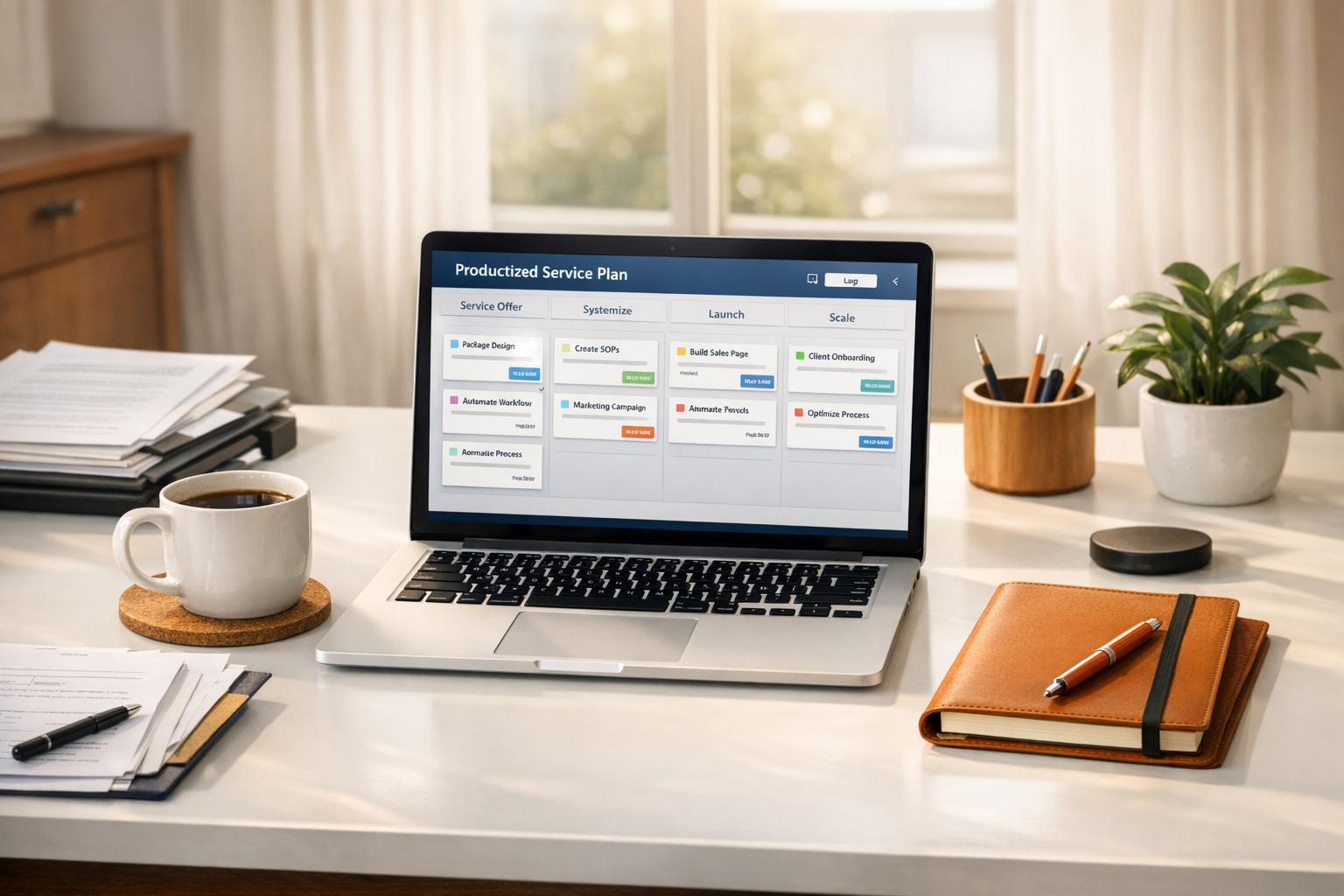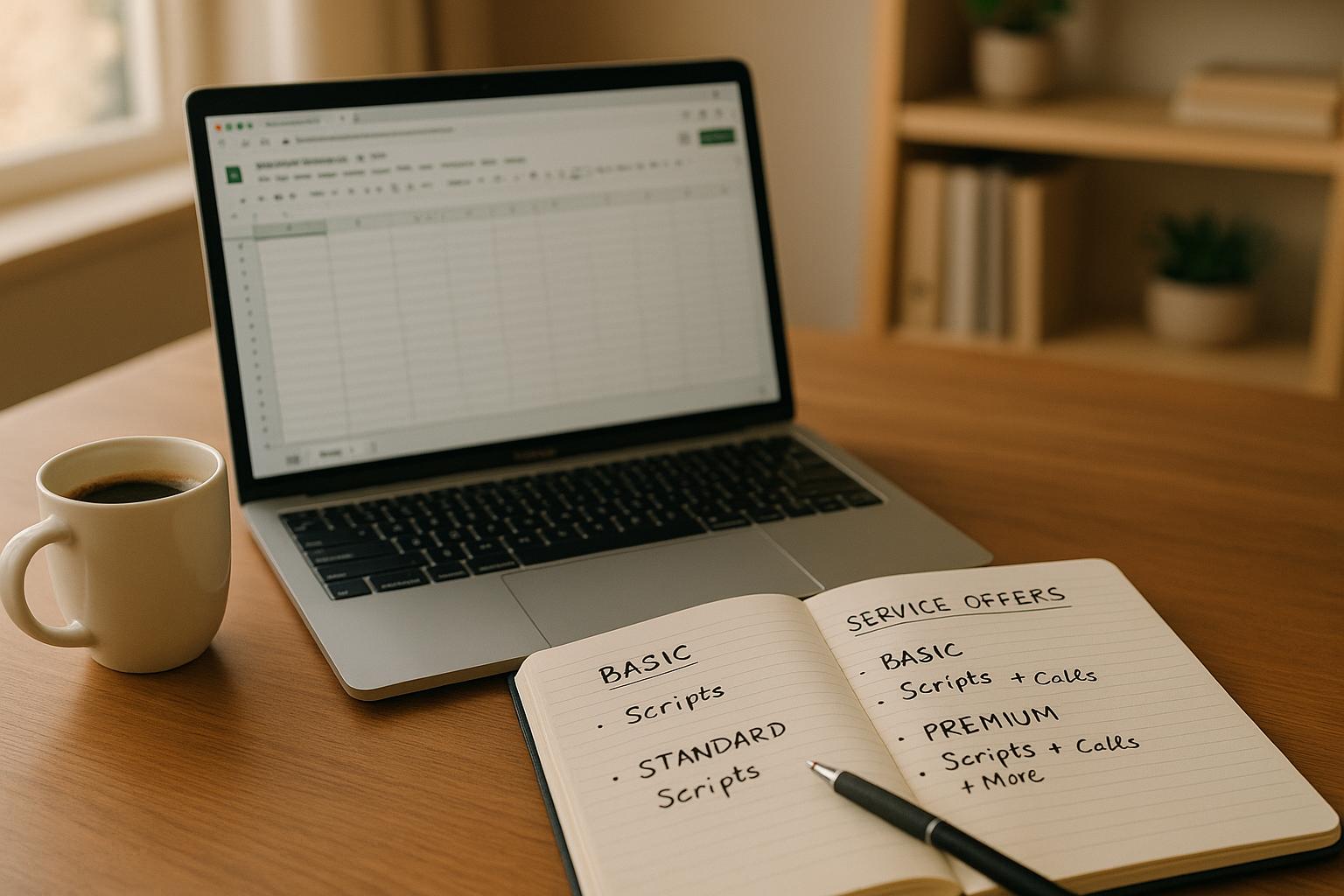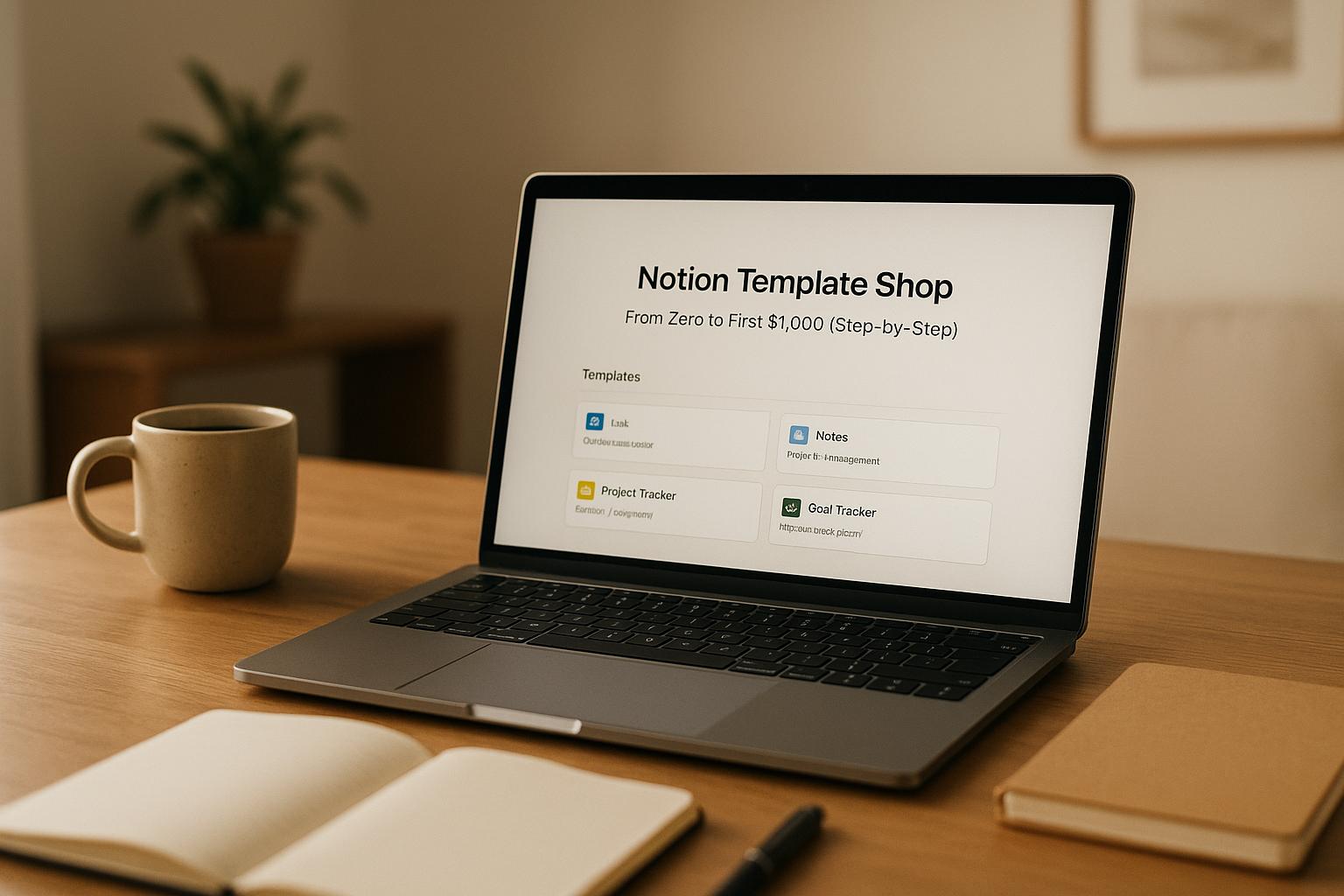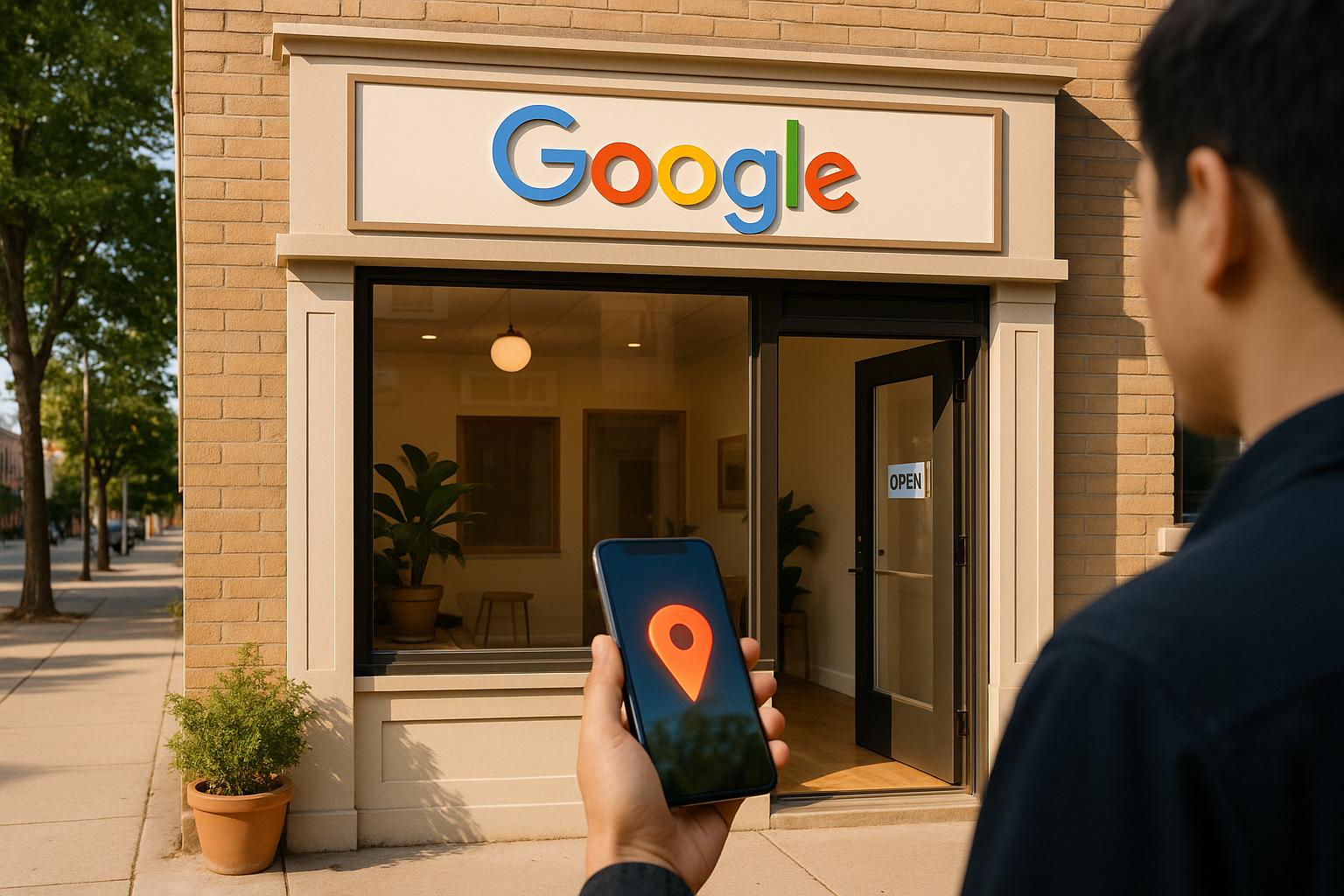
Google Business Profile (GBP) is your business’s online storefront on Google Search and Maps. It’s the key to appearing in the coveted Local Pack: the top three local business results displayed with a map. This guide explains how to set up, optimize, and manage your GBP to improve visibility, attract local customers, and drive meaningful engagement.
Key Takeaways:
- What is GBP? A free tool to showcase your business details (hours, address, reviews, photos) on Google.
- What is the Local Pack? A prominent section in search results showing three local businesses based on relevance, proximity, and reputation.
- Why it matters: Local searches often lead to immediate customer actions, like calls, visits, or purchases.
- Setup Steps:
- Create or claim your profile at business.google.com.
- Add accurate business details (name, address, phone, hours).
- Verify your profile via postcard, phone, or email.
- Optimization Tips:
- Ensure consistency across all platforms (name, address, phone).
- Add high-quality photos and use location-specific keywords.
- Pick the most specific category for your business and relevant attributes.
- Engage with customers by responding to reviews and posting updates.
By following these steps and keeping your profile active, you can increase your chances of appearing in the Local Pack, driving more high-intent traffic to your business.
Google Business Profile Setup for 2025 (Step-by-Step Tutorial)
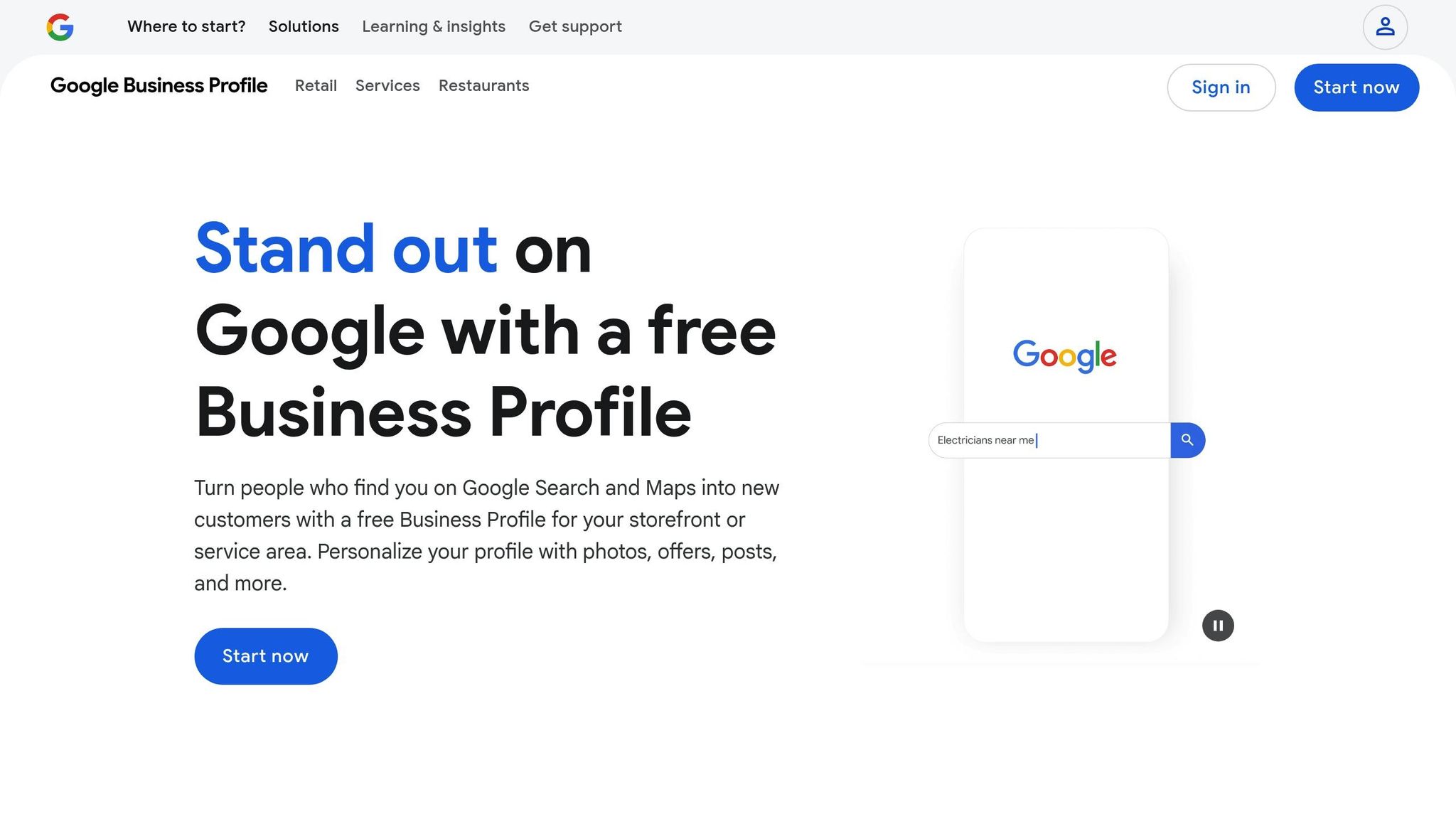
Google Business Profile and Local Pack Basics
Before diving into setup and optimization, let’s cover the essentials of Google Business Profile (GBP) and the Local Pack.
What is Google Business Profile?
Google Business Profile is a free tool that showcases your business details - like hours, phone number, address, website, photos, and reviews - on Google Search and Maps. Think of it as your digital storefront.
Your GBP pops up in several key places. If someone searches for your business name, it appears on the right side of the search results. Even better, it shows up in local search results when people look for businesses like yours nearby.
What makes GBP stand out? Its interactive features. Customers can call you directly, get directions, view photos, read reviews, and even ask questions - all from your profile. This ease of access often plays a huge role in whether someone picks your business over another.
What is the Local Pack?
The Local Pack is the eye-catching box at the top of search results that highlights three local businesses with key details. It’s prime online real estate, sitting above the standard search results and drawing immediate attention.
For example, when someone searches “coffee shops near me” or “plumber in Denver,” the Local Pack displays three nearby options, complete with their ratings, reviews, and contact info. The businesses featured here enjoy a significant visibility boost compared to those further down the page.
Here’s the kicker: the Local Pack pulls its data directly from Google Business Profiles. Whether your business appears here depends on a few factors, including how close you are to the searcher, how relevant your business is to their query, and your online prominence (think reviews, ratings, and overall reputation).
Getting into the Local Pack can mean more clicks - and not just any clicks. These are high-quality leads, often from people ready to make a purchase or visit your location.
Google Business Profile Requirements
To qualify for a Google Business Profile, your business needs a physical location or must provide direct services to customers.
This means you must have direct interactions with customers. For instance, you can’t create a profile for a warehouse that only ships products or a corporate office that doesn’t serve the public. Google’s goal is to feature businesses that local customers can visit or hire.
Make sure your business name matches official records - avoid stuffing it with extra keywords or promotional phrases.
Verification is also key. Most businesses verify their profile by receiving a postcard with a code at their physical address. In some cases, phone or email verification may be an option, but the postcard method is the most common.
Lastly, your business must follow Google’s content policies. Profiles with misleading or prohibited information - or those linked to restricted industries like illegal activities or adult content - won’t be eligible.
Once you meet these requirements, you’re ready to claim and optimize your profile for maximum impact.
How to Set Up Your Google Business Profile
Getting your Google Business Profile set up the right way from the beginning can save you time and help boost your visibility in local search results. The process involves three key steps, each building on the last.
Create and Claim Your Profile
Start by heading to business.google.com and signing in with a Google Account. If you don’t already have one, create an account using an email address that you’ll regularly check - this is where important notifications about your profile will be sent.
Once logged in, click "Manage now" and enter your business name exactly as it appears in your official records. Google will check for existing profiles that match your business name and location.
- If your business is already listed, click "Claim this business" and follow the instructions. This often happens if Google has created a basic profile using publicly available data or if a customer suggested your business.
- If no listing exists, click "Add your business to Google" and fill in your details.
Tip: Stick to one Google Account for managing your profile. Using multiple accounts for the same business can confuse Google and hurt your rankings.
Once you’ve claimed or created your profile, make sure all the details are accurate before moving forward.
Add Your Business Information
Accurate and consistent information strengthens your profile’s credibility and helps customers find you.
- Business Name: Use the name customers know you by. If your legal business name differs from the name customers recognize, go with the customer-facing name.
- Address: Enter your complete street address exactly as it appears on mail delivery records. Avoid abbreviations unless that’s how it’s officially listed. For example, write "Street" instead of "St." and include the ZIP+4 code when possible (e.g., 90210-1234).
- Phone Number: Use a local number that connects directly to your business location. Avoid toll-free numbers or call centers that route calls to multiple locations. Format it as (555) 123-4567 for consistency.
- Primary Category: Choose the most specific category that describes your main service. For example, if you run an Italian restaurant, select "Italian Restaurant" instead of the broader "Restaurant."
- Service Area: If you travel to customers, define your service area using cities, ZIP codes, or a radius (up to 100 miles). Be realistic - overstating your area can negatively impact your rankings.
- Operating Hours: Enter your hours in local time, using the 12-hour format (e.g., 9:00 AM - 6:00 PM). If you’re open 24/7, select the 24/7 option. Don’t forget to add special hours for holidays.
Once all this information is entered, you’ll be ready to verify your profile.
Complete the Verification Process
Verifying your profile is essential - it confirms you’re authorized to manage the listing and activates it for public searches. Google offers a few verification methods, but postcard verification is the most common for U.S. businesses.
- Postcard Verification: Google will mail a postcard to your business address within 5-7 business days. It includes a unique verification code. Make sure someone can receive mail at your location, and if you’re in a shared building, include your suite number and any special instructions.
- Phone Verification: Some businesses may qualify for phone verification, especially if they’ve been around for a while and have consistent online information. If eligible, you’ll receive an automated call with a verification code in minutes.
- Email Verification: This option is rare and typically offered to businesses Google trusts. If available, you’ll get an email with a unique link to complete the process.
- Video Verification: In some cases, Google might require a video call to confirm your location and documentation.
Once you receive the verification code, enter it in your dashboard before it expires (usually within 30 days).
Pro tip: If your postcard doesn’t arrive within 14 days, request a new one through your dashboard. Delays can happen, especially during busy seasons or in areas with tricky delivery routes.
Once verified, your profile will be fully active and eligible to appear in the Local Pack. Most updates you make will show up in search results within 24-48 hours, though some changes may take longer to reflect.
How to Optimize Your Google Business Profile for Higher Rankings
Once your Google Business Profile (GBP) is set up, the next step is to fine-tune every detail to climb higher in the Local Pack rankings. Let’s start by ensuring your business information is consistent across all platforms.
Keep Information Consistent Across All Platforms
Consistency plays a huge role in local SEO success. Google cross-checks your business details across countless directories, review sites, and social platforms. Any discrepancies can confuse users - and Google - which can ultimately hurt your rankings.
Your NAP (Name, Address, Phone number) must match perfectly across your website, Facebook, Yelp, and any other listings. For example, always use the exact same format: "123 Main Street, Suite 4B" and "(555) 123-4567" everywhere.
Here are a few common problem areas to watch out for:
- Address formatting: Stick to the official format registered with postal services. Even small differences, like "St." versus "Street", can create inconsistencies.
- Business name variations: If your official name is "Johnson's Auto Repair LLC" but people know you as "Johnson's Auto", choose one version and stick with it across every platform.
To avoid mistakes, create a simple spreadsheet with your exact business details. Use it as a reference whenever you update or add listings. This small effort can save you from headaches down the road.
Once your information is uniform, it’s time to make your profile more engaging and relevant.
Add Quality Photos and Use Local Keywords
After ensuring your details are consistent, elevate your profile by adding eye-catching photos and strategically incorporating local keywords. High-quality images not only attract attention but also build trust with potential customers. Google prioritizes profiles with fresh, engaging visuals because they improve the user experience.
Aim to upload 10-15 photos that showcase your business in these key areas:
- Logo and exterior: Help customers recognize your brand and location.
- Interior and product/service shots: Highlight what you offer and your business environment.
- Team photos: Put a human face on your business to connect with customers.
When writing photo captions or descriptions, weave in local keywords naturally. Instead of generic phrases like "Best pizza in town", try something more specific, such as "Authentic wood-fired pizza in downtown Springfield" or "Family-owned Italian restaurant serving the Riverside neighborhood since 1985." These details help Google associate your business with specific locations, improving your visibility in local searches.
Choose the Right Categories and Attributes
Once your profile looks polished, focus on selecting the best categories and attributes to target your ideal audience effectively. Your primary category is one of the most critical factors for ranking. It tells Google exactly what your business does and determines which searches you’ll show up for.
Pick the most specific primary category that fits your business. Then, add relevant secondary categories (up to nine) to cover additional services without diluting your main focus. For example, a bakery might choose "Bakery" as the primary category and add secondary options like "Coffee Shop" or "Catering."
Attributes provide even more context about your business and can help you stand out in searches. These include details like:
- "Wheelchair accessible"
- "Women-owned"
- "Outdoor seating"
- "Free Wi-Fi"
Enable all attributes that genuinely apply to your business, especially those that matter most to your target audience.
It’s a good idea to review your categories and attributes regularly - every few months or so. As your business grows or Google updates its category options, you might find better matches that can boost your visibility in relevant searches.
sbb-itb-08dd11e
Use Google Business Profile Features to Get Visible Faster
Your Google Business Profile offers more than just the basics - it’s packed with tools that can help your business stand out in local searches. By using these features, you can engage with customers directly and show Google that your business is active and responsive.
Manage and Respond to Customer Reviews
Customer reviews play a major role in how Google ranks local businesses. Make it a habit to respond to every review, whether it's glowing praise or constructive criticism. When replying, aim to be professional, clear, and approachable. Avoid short, generic responses - they can come across as dismissive.
Negative reviews can actually be an opportunity to shine. Address the specific concerns raised, and if possible, offer a solution or compensation. This shows potential customers that you care about their experience and are willing to make things right. Thoughtful responses not only build trust but can also influence future customers' decisions.
Post Updates, Offers, and Events
Regular posting on your profile is another way to boost your visibility. Google Posts help keep your business fresh in both search results and customers' minds. Use these posts to share special offers, making sure they go live before the promotion starts and stay active for the right duration. Highlighting local events like community fairs or in-store workshops also keeps your profile relevant and engaging for your audience.
Video content is a standout feature for Google Business Profile posts. Google often highlights videos in Local Pack results, so consider creating short, 30-second clips. A café might showcase the preparation of its most popular drink, while a boutique could feature new arrivals or behind-the-scenes footage.
When writing posts, include local keywords that match what your audience is searching for. For instance, instead of saying, "New menu items available", try something like, "Fresh seafood specials now available at our downtown Riverside location." This not only makes your posts more relevant but also helps with local search rankings.
Aim to post two to three times a week. Share updates, promotions, or community news that offer real value - whether it’s a discount, helpful information, or a sneak peek into your business operations. This consistent activity can make a big difference in how visible and appealing your profile is to both Google and your customers.
Use Google Business Profile Data to Validate Your Business Ideas
Your Google Business Profile (GBP) is more than just a tool for boosting local search visibility - it’s a treasure trove of customer insights that can guide smarter business decisions. By tapping into the data your GBP provides, you can better understand customer preferences and refine your strategies to meet their needs.
Analyze Customer Feedback and Engagement
Customer reviews are a goldmine when it comes to understanding your audience. They reveal what your customers value most - whether it’s fast service, helpful staff, or other standout features. At the same time, they can highlight areas that need improvement, like long wait times or inconvenient parking. For instance, if several reviews mention “friendly staff” or “quick service,” these are strengths you can emphasize. On the flip side, repeated mentions of challenges like limited parking signal areas for potential improvement.
This feedback isn’t just about identifying problems; it’s about spotting opportunities. By analyzing recurring themes in reviews, you can make adjustments that align with customer expectations and even uncover unmet needs. Advanced tools can take this a step further, helping you dig deeper into the data for actionable insights.
Combine GBP Data with AI Tools
To make the most of your GBP insights, consider integrating AI tools into your analysis. These tools can process large volumes of customer feedback and engagement metrics quickly, turning raw data into clear, actionable strategies. For example, platforms like IdeaFloat specialize in helping businesses validate ideas by analyzing customer behavior and preferences.
AI tools can also generate detailed performance reports, breaking down feedback by product categories, service areas, or even seasonal trends. This allows you to test new ideas - like a product line or service expansion - against actual customer needs before making a significant investment. Additionally, AI can assist in generating tailored responses to reviews, improving your customer engagement without requiring extra time or effort.
Key Steps for Local Pack Success
Getting your business to show up in Google's Local Pack takes careful planning and consistent effort. The first step is to claim and verify your Google Business Profile, which is typically done through their postcard verification process. Make sure your Name, Address, and Phone Number (NAP) are identical across all platforms - this consistency is crucial.
Once your profile is set up, focus on adding high-quality visuals and incorporating relevant keywords. Pay close attention to your category selection, as it plays a big role in determining which searches will display your business. Don’t stop at just one category - add secondary categories and attributes that highlight your business’s features, like "wheelchair accessible" or "accepts credit cards."
Staying active on your profile is just as important. Respond to customer reviews within 24-48 hours, answer any questions promptly, and keep your profile updated with posts about special offers, events, or news. This kind of engagement not only helps your customers but also signals to Google that your business is active and relevant.
Use the data from your profile to fine-tune your approach. For example, track which photos are getting the most attention, see how customers are discovering your business, and analyze review trends to spot areas for improvement. Tools like IdeaFloat can help you dig deeper into this information, turning customer feedback into actionable strategies that can boost your local search visibility.
FAQs
What can I do to make sure my Google Business Profile shows up in the Local Pack regularly?
To boost your chances of showing up consistently in the Local Pack, make sure your Google Business Profile (GBP) is fully filled out, accurate, and optimized. Double-check that your business details - such as address, phone number, and hours of operation - are current, and don’t forget to verify your business location.
Interact with your customers by responding to reviews and encouraging positive ones. Reviews not only build trust but can also improve your visibility. Adding high-quality photos of your business, products, or services is another way to grab attention. Lastly, incorporate local keywords into your business description and services to match search intent and strengthen your local rankings.
How can I use my Google Business Profile to connect with customers effectively?
To make the most of your Google Business Profile and truly connect with your customers, start by engaging with reviews - whether they're glowing or critical. Responding thoughtfully shows that you value feedback and are committed to customer satisfaction.
Keep your profile lively by posting regular updates. Share promotions, announce special events, or introduce new products to keep your audience interested and informed.
Don’t underestimate the power of visuals. Upload high-quality photos and videos that showcase your business, as they can capture attention and leave a strong first impression.
Enable the messaging feature so customers can reach out directly with questions, and make it a priority to reply quickly - this builds trust and strengthens relationships. Lastly, make good use of the Q&A section by providing clear, concise answers to common questions. This helps customers get the information they need without any hassle.
How can I use my Google Business Profile to grow my business effectively?
Your Google Business Profile (GBP) is a treasure trove of insights that can help fine-tune your business approach. Start by making sure every detail on your profile is accurate and up to date. This includes your address, phone number, business category, and any relevant attributes. Don’t forget to update your operating hours regularly and upload high-quality photos to make your profile stand out.
Customer reviews are another crucial element. Responding to reviews - both positive and negative - quickly and professionally not only builds trust but also enhances your profile’s visibility. Dive into GBP metrics like customer actions, search queries, and location data to see how people discover and interact with your business. These insights can guide adjustments to your marketing strategies, helping you better connect with your audience.
Related Blog Posts
Get the newest tips and tricks of starting your business!
